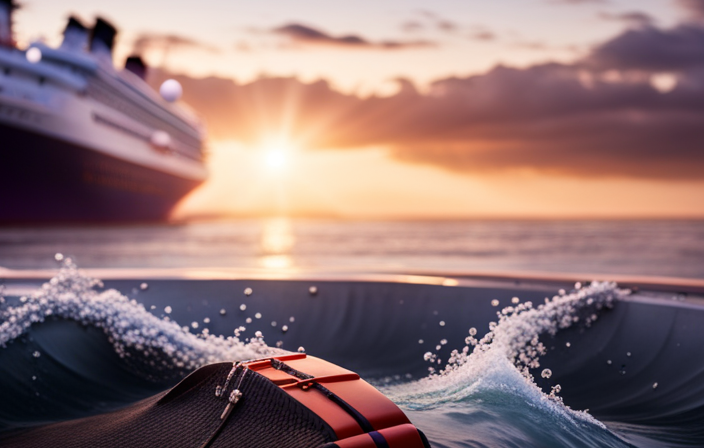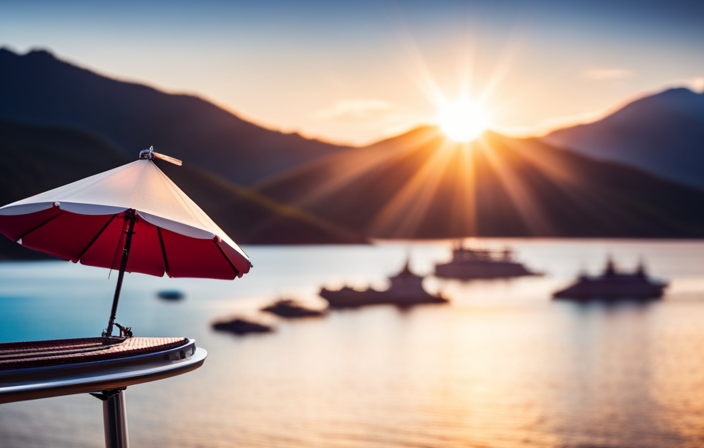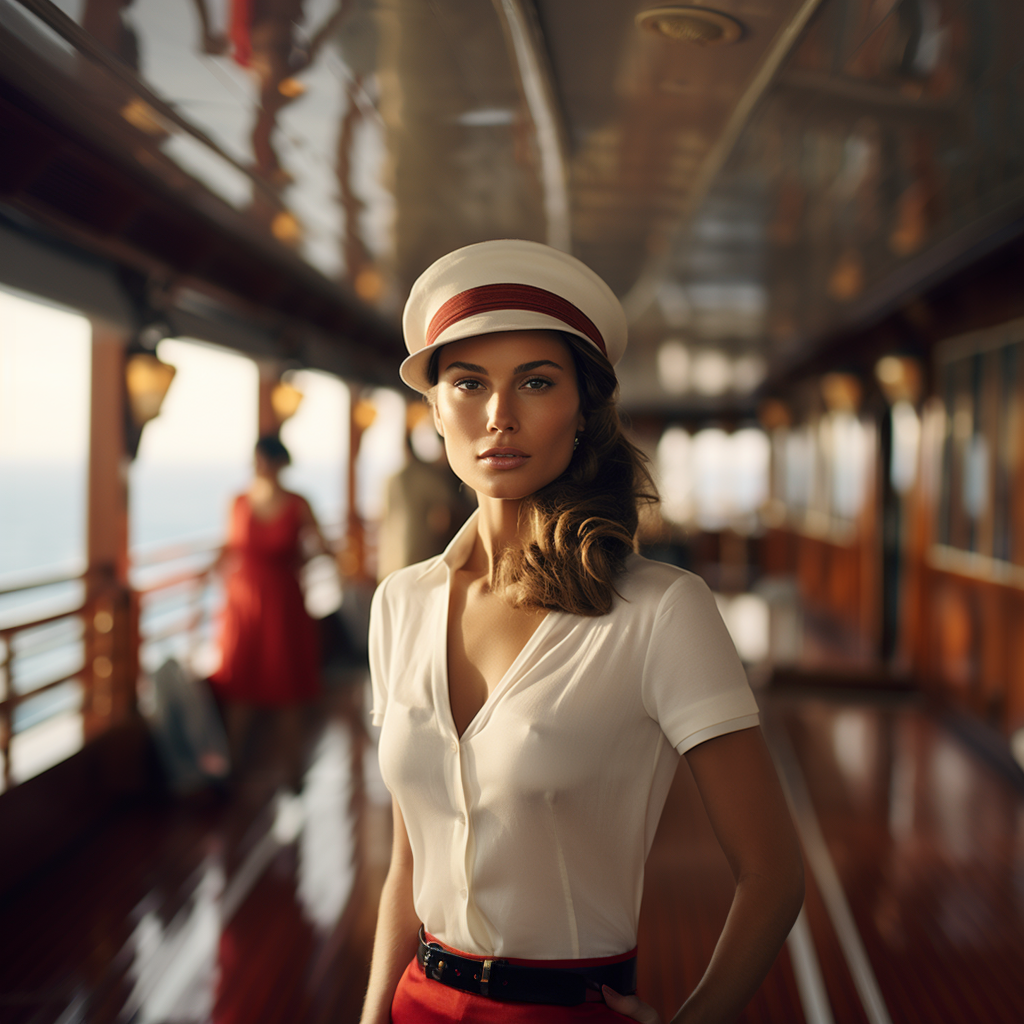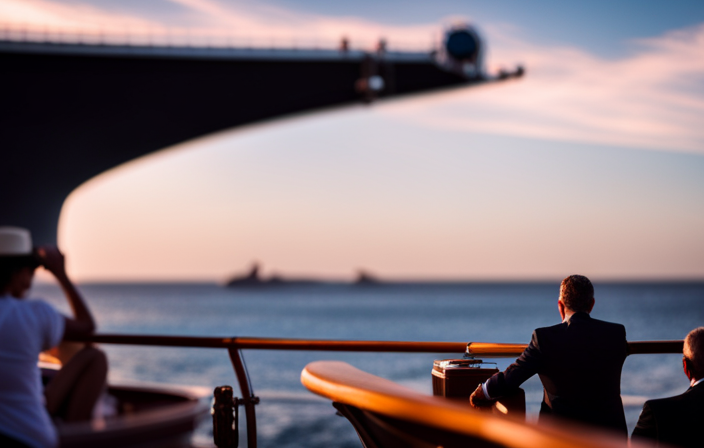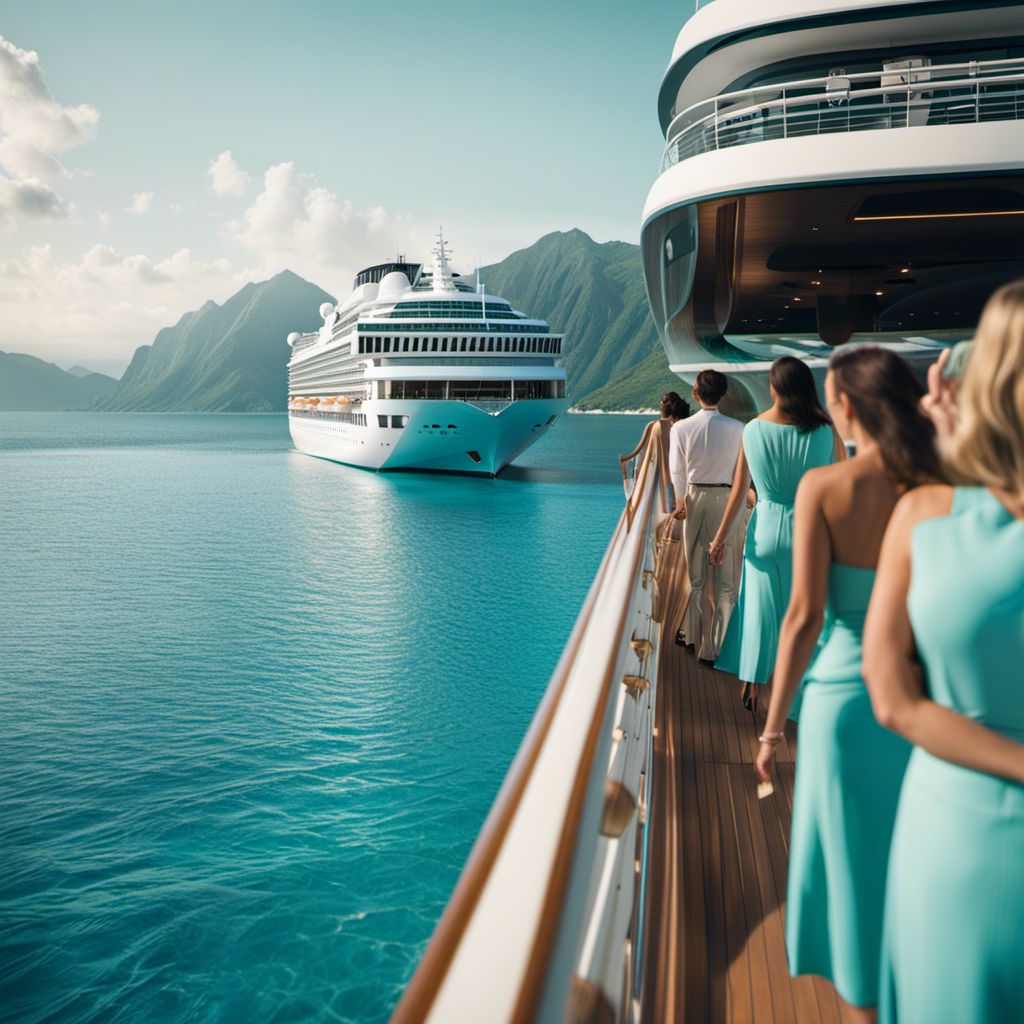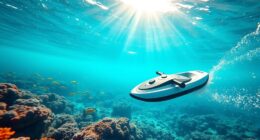Setting sail across the vast ocean, I’m left contemplating the safety of cruise ships. How often do these giant vessels end up surrendering to the depths of the sea? Can we truly rely on the security of these floating cities as much as they claim?
In this article, we will delve into the intriguing world of cruise ship safety, examining historical data, analyzing statistics, and exploring the factors contributing to sinkings. Through a detailed and analytical approach, we will uncover the truth behind the common misconceptions and shed light on the role of technology in ensuring the well-being of passengers.
Furthermore, we will compare the safety of cruise ships with other modes of transportation, providing a comprehensive perspective on the matter. So, join me on this journey as we navigate the reality of cruise ship sinkings and discover how to ensure a safe and enjoyable experience on the open seas.
Key Takeaways
- Cruise ships have a much lower accident and fatality rate compared to other forms of transportation, such as cars, airplanes, and trains.
- Evacuation procedures, emergency response training, and safety drills are important aspects of cruise ship safety protocols.
- Climate change poses challenges to cruise ship safety, requiring adaptation and necessary precautions from cruise lines.
- Well-trained and experienced crew members play a vital role in preventing sinkings and responding to emergencies, emphasizing the importance of continual improvement in crew training programs.
Understanding Cruise Ship Safety Measures
Did you know that cruise ships have implemented numerous safety measures to ensure the well-being of passengers?
One of these measures is conducting regular emergency drills for both crew members and guests. These drills help familiarize everyone on board with the necessary procedures in case of an emergency.
Crew members also undergo extensive training to handle various situations that may arise at sea. The importance of crew training cannot be overstated, as their quick response and knowledge can save lives during critical moments.
By ensuring that all crew members are well-prepared, cruise ships are able to provide a safer environment for their passengers.
Now, let’s examine historical data on cruise ship sinkings to gain a deeper understanding of their frequency and causes.
Examining Historical Data on Cruise Ship Sinkings
Rarely has there been a time in history when cruise ships have tragically succumbed to the depths of the sea. Examining factors that contribute to cruise ship sinkings reveals important insights into the safety of these vessels. Analyzing trends in historical data on cruise ship sinkings allows us to understand the risks involved and the measures that have been taken to prevent such accidents.
From this analysis, it becomes evident that cruise ships sinking is an extremely rare occurrence. Stringent safety measures, such as advanced navigation systems, emergency evacuation procedures, and regular inspections, have significantly reduced the likelihood of sinkings. However, it is important to continue examining and improving these safety measures to ensure the continued safety and enjoyment of passengers.
Transitioning into the subsequent section about statistical analysis of cruise ship accident rates, it is crucial to delve deeper into the numbers to gain a comprehensive understanding of the overall safety of cruise ships.
Statistical Analysis of Cruise Ship Accident Rates
Statistical analysis reveals fascinating insights into the safety record of cruise ships, allowing us to appreciate the impressive track record these vessels have when it comes to accidents.
Examining global cruise ship accident trends, it is evident that sinkings are extremely rare occurrences. In fact, the probability of a cruise ship sinking is significantly low compared to other modes of transportation. This analysis also highlights the importance of weather conditions in evaluating cruise ship sinkings.
While adverse weather can pose challenges for these massive vessels, the industry has implemented robust safety measures and protocols to mitigate risks. Understanding the impact of weather conditions on cruise ship sinkings is crucial for ensuring passenger safety.
Transitioning into the next section on factors contributing to cruise ship sinkings, it is essential to examine other significant aspects that might affect the safety of these vessels.
Factors Contributing to Cruise Ship Sinkings
Passengers aboard cruise ships may find themselves in a precarious situation when unforeseen circumstances arise, such as treacherous storms or unexpected collisions. Several factors can contribute to cruise ship sinkings, including the stability of the ship itself and the impact of weather conditions.
The design and construction of a cruise ship play a crucial role in its ability to withstand the forces of nature. Factors such as the ship’s size, weight distribution, and ballast system can affect its stability in rough seas.
Additionally, weather conditions such as strong winds, heavy rainfall, and high waves can pose significant risks to the safety of a cruise ship. Understanding these factors and their potential consequences is essential for ensuring the safety of passengers and crew.
Moving forward, it is crucial to explore how technology can play a role in enhancing cruise ship safety, which will be discussed in the next section.
The Role of Technology in Ensuring Cruise Ship Safety
To ensure your safety on a cruise ship, technology plays a vital role in enhancing security measures and mitigating potential risks. The role of AI in cruise ship safety can’t be underestimated.
With advancements in surveillance technology for cruise ships, AI systems can monitor the ship’s surroundings and detect any potential threats or hazards in real-time. These AI systems can analyze data from various sensors, such as radar and sonar, to identify and track objects or vessels that pose a risk.
Additionally, AI can help predict and prevent accidents by identifying patterns and anomalies in the ship’s operations. This proactive approach allows for timely interventions and helps prevent potential disasters.
Furthermore, surveillance technology on cruise ships has advanced significantly, with high-definition cameras, thermal imaging, and facial recognition systems ensuring comprehensive monitoring of both passengers and crew. These technological advancements not only enhance safety but also provide valuable data for future improvements in cruise ship security.
Moving into the subsequent section about safety regulations and protocols in the cruise industry, it’s essential to understand how these technologies align with established standards and guidelines.
Safety Regulations and Protocols in the Cruise Industry
After discussing the role of technology in ensuring cruise ship safety, it’s important to delve into the specific safety regulations and protocols that are in place within the cruise industry. These regulations are crucial for understanding cruise ship evacuation procedures and evaluating the effectiveness of crew training.
The International Maritime Organization (IMO) has established a set of mandatory regulations known as the International Convention for the Safety of Life at Sea (SOLAS), which all cruise ships must comply with. SOLAS covers various aspects of safety, including emergency systems, fire protection, and life-saving appliances.
Additionally, cruise lines have their own safety protocols and procedures that are continuously evaluated and updated. These measures aim to ensure the well-being and security of passengers and crew members.
Now, let’s explore some common misconceptions about cruise ship sinkings.
Common Misconceptions about Cruise Ship Sinkings
Don’t worry, there are some common misconceptions about cruise ship sinkings that you may be surprised to learn aren’t true. Despite public perception, cruise ship sinkings are actually extremely rare occurrences.
The media often sensationalizes these incidents, leading people to believe that they happen more frequently than they actually do. In reality, cruise ships are designed with numerous safety features and undergo rigorous inspections to ensure their seaworthiness. Additionally, the International Maritime Organization (IMO) sets strict regulations and protocols that cruise ships must adhere to in order to maintain the safety of their passengers and crew.
While it’s important to be aware of safety precautions and emergency procedures, it’s equally important not to let misconceptions cloud our judgment.
Now, let’s explore how cruise ship safety compares to other modes of transportation.
Comparing Cruise Ship Safety with Other Modes of Transportation
You’ll be pleasantly surprised to discover how cruise ship safety stacks up against other modes of transportation. When comparing safety records, it’s important to consider the risk assessment procedures implemented by each industry. While accidents can happen in any form of transportation, cruise ships have rigorous safety protocols in place to minimize risks and ensure passenger safety.
To put things into perspective, let’s compare the safety records of cruise ships with other common modes of transportation:
| Mode of Transportation | Annual Number of Accidents | Annual Number of Fatalities |
|---|---|---|
| Cruise Ships | 1-2 | 0 |
| Cars | Millions | Thousands |
| Airplanes | Hundreds | Hundreds |
| Trains | Thousands | Hundreds |
As you can see, cruise ships have an impressive safety record compared to other forms of transportation. Now, let’s move on to tips for ensuring a safe and enjoyable cruise experience.
Tips for Ensuring a Safe and Enjoyable Cruise Experience
To fully immerse yourself in the joy of cruising, follow these expert tips to ensure a safe and delightful experience on the high seas.
-
Familiarize yourself with cruise ship evacuation procedures: Before setting sail, take the time to review the ship’s emergency evacuation plan. Locate the nearest lifeboats, muster stations, and emergency exits. Knowing these crucial details will help you feel more secure in case of an emergency.
-
Trust in the emergency response training for cruise ship staff: Cruise lines prioritize safety and invest in extensive training for their crew members. From the captain to the housekeeping staff, everyone undergoes rigorous emergency response training. Rest assured that you’re in capable hands if an unexpected situation arises.
-
Be vigilant and observant: While onboard, pay attention to safety announcements, participate in safety drills, and familiarize yourself with important information displayed in your cabin. Stay alert to any potential hazards and report any concerns to the ship’s staff.
Transitioning to the subsequent section about the reality of cruise ship sinkings, it’s important to understand the precautions you can take for a safe voyage.
Conclusion: The Reality of Cruise Ship Sinkings
In the end, understanding the reality of cruise ship sinkings sheds light on the importance of being informed and prepared for any potential risks that may arise at sea.
One factor that can greatly impact cruise ship safety is climate change. Rising sea levels, extreme weather events, and changing ocean currents can all pose significant challenges to the navigation of cruise ships. It’s crucial for cruise lines to adapt to these changing conditions and take necessary precautions to ensure the safety of their passengers and crew.
Another essential aspect of preventing cruise ship sinkings is crew training. Well-trained and experienced crew members play a vital role in responding to emergencies, conducting regular safety drills, and implementing proper maintenance and inspection procedures. By continually improving crew training programs and staying updated on the latest safety regulations, cruise lines can effectively minimize the risk of sinkings and provide a safe and enjoyable experience for their passengers.
Frequently Asked Questions
What are some common misconceptions about cruise ship sinkings?
Common myths about cruise ship sinkings are perpetuated by media portrayal. These misconceptions often exaggerate the frequency and severity of such incidents, leading to unnecessary fear and anxiety among potential cruisers.
How does cruise ship safety compare to other modes of transportation?
Compared to airplanes and trains, cruise ship safety is often overlooked. However, statistics show that cruise ships have a lower accident rate. They are equipped with advanced safety measures, making them a secure mode of transportation.
What safety regulations and protocols are in place in the cruise industry?
Safety regulations in the cruise industry are rigorous and comprehensive. They encompass all aspects of ship operations, including emergency protocols. These measures ensure the highest level of safety for passengers and crew members at all times.
What role does technology play in ensuring cruise ship safety?
AI and surveillance technology play crucial roles in ensuring cruise ship safety. AI analyzes data to predict and prevent accidents, while surveillance technology monitors areas for potential hazards. These innovations greatly enhance the overall safety of cruise ship operations.
What are some tips for ensuring a safe and enjoyable cruise experience?
To ensure passenger well-being, cruise lines prioritize safety through rigorous emergency procedures and drills. Passengers should familiarize themselves with emergency exits, attend safety briefings, and follow crew instructions for a safe and enjoyable cruise experience.
Do Cruise Ships Sink More Often at Certain Times of the Year?
Cruise ships do not sink more often at specific times of the year. They are built to withstand various weather conditions. The best time to book a cruise is during wave season, from January to March, for great deals and promotions. Always research and book early for the best availability.
Conclusion
After diving deep into the data and examining the safety measures in place, it’s safe to say that cruise ship sinkings are an extremely rare occurrence.
In fact, the chances of a cruise ship sinking are about as likely as finding a unicorn in your backyard.
With advanced technology, rigorous regulations, and highly trained crew members, the cruise industry has made remarkable strides in ensuring passenger safety.
So, fear not! Embark on your next cruise adventure with confidence and enjoy the luxurious and worry-free experience that awaits you.
Meet Asra, a talented and adventurous writer who infuses her passion for exploration into every word she writes. Asra’s love for storytelling and her insatiable curiosity about the world make her an invaluable asset to the Voyager Info team.
From a young age, Asra was drawn to the power of words and their ability to transport readers to far-off lands and magical realms. Her fascination with travel and cultures from around the globe fueled her desire to become a travel writer, and she set out on a journey to turn her dreams into reality.

